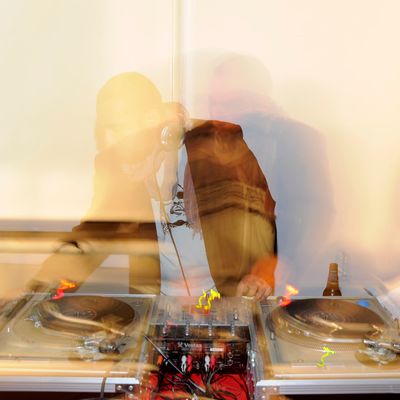
What does an august museum do when it feels stodgy? WhatÔÇÖs the institutional equivalent of a midlife crisis? To the 6 million visitors who march through its halls each year, the Metropolitan Museum of Art may seem like a sublime and lively place. Even so, the Met has hired itself a relevance guru: Paul D. Miller, a.k.a. DJ Spooky That Subliminal Kid, the turntable master who careers from topic to topic with the mild inquisitiveness of an intellectual souvenir collector and the sonic adventurousness of customer-service-line hold music. The Met didnÔÇÖt just decide to present Miller in a five-concert series; it named him the museumÔÇÖs first artist-in-residence, overhauled the Grace Rainey Rogers Auditorium to satisfy his technical needs, and tapped various curators and departments to participate in a yearlong festival of interdisciplinary high jinks called ÔÇ£The Met Reframed.ÔÇØ Remind me: Why does the Met need reframing?
DJ Spooky began last fall by recomposing the soundtrack to the 1956 Korean film Madame Freedom. He continues in March with a performance of ice-themed music so intercontinentally mind-blowing that he had to make a polar expedition in order to write it. In between came The Nauru Elegies, the product of his sojourn on a tiny South Pacific island. The Kid, who is actually 42, performed the piece on a recalcitrant laptop and a pair of iPad virtual turntables, operated by an app he helped design and accompanied by a teenage string quartet. It must have all seemed like such a great idea to the Met: technology, kids, video imagery, exotic locale, intellectual heft, social critique, and a bowlful of buzzwords.
The premise was promising, too. Far from being a tropical paradise, Nauru is a node of international rapacity. Tiny and low-slung, itÔÇÖs going to feel climate change early and hard. The Japanese hunkered down there during World War II, pocking the island with bunkers. Its rich phosphate deposits have mostly been stripped away, leaving a landscape marred by rusting machinery and eerie limestone pinnacles. The Russian Mafia has laundered fortunes through the islandÔÇÖs banks. Virtually the entire population is unemployed, and the country has had such difficulty paying its bills that it has sometimes seen its airline grounded and its phone service cut off.┬á
Miller treated this place of epic misery as a source of inspiration, though what he wound up extracting was a home movie with a shrink-wrapped soundtrack ÔÇö aesthetically impoverished and self-important. During his stay, he wandered around the bleak Pacific rock, shooting wobbly footage with a handheld camera. He took an audio recorder and taped a choir singing a hymn. Then he supplemented this thin dossier with dull computer graphics and a score that bubbles obliviously along, leaving a trail of dishwater beats. From time to time, a bit of text flashed on the screen, like this gem from the Columbia literature professor Gayatri Chakravorty Spivak: ÔÇ£The fall into the abyss of deconstruction inspires us with as much pleasure as fear. We are intoxicated with the prospect of never hitting bottom.ÔÇØ
I canÔÇÖt imagine what Spooky hopes audiences will make of his collection of gnomic epigrams, or of his glancing references to ÔÇ£culture,ÔÇØ ÔÇ£language,ÔÇØ ÔÇ£architecture,ÔÇØ ÔÇ£virtuality,ÔÇØ and ÔÇ£economics.ÔÇØ He stirs together notes, pictures, and abstract concepts, all the while peddling the illusion that he has something trenchant to say. We should be long past the desperate days when manipulating turntables or invoking the rag ends of hip-hop was enough to make an artist seem crucial.
MillerÔÇÖs gifts are not great, but apparently they are persuasive. A conclave of festivals, presenters, and museums has anointed him hip-hopÔÇÖs emissary to the high-culture Establishment. That Subliminal Kid passes for a philosopher prince. The Met is gearing up to announce its next artist-in-residence. LetÔÇÖs hope this time the museum picks someone who doesnÔÇÖt mistake dilettantism for depth.


